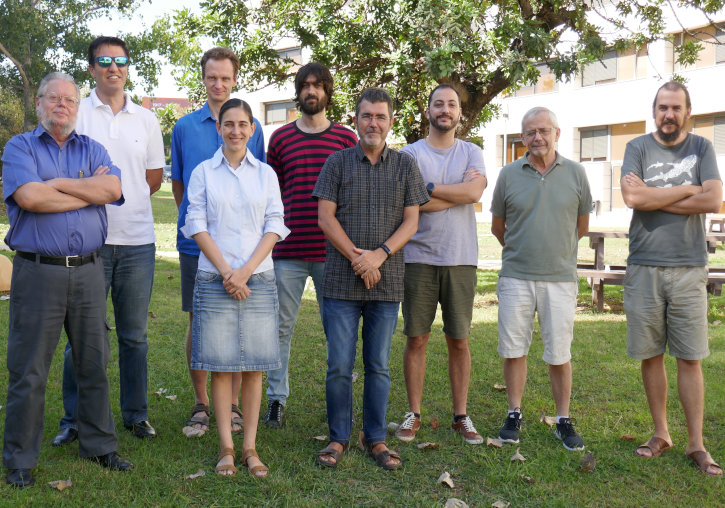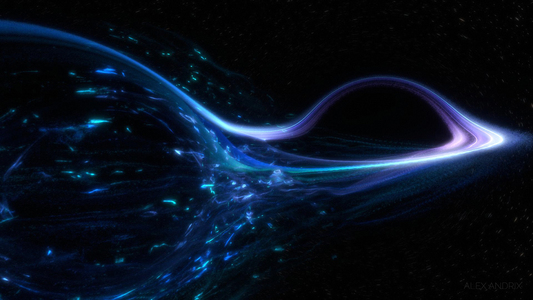The University of Valencia participates in the detection of a mysterious object merging with a black hole
- Scientific Culture and Innovation Unit
- June 23rd, 2020

The University of Valencia has participated in the discovery of a compact object of approximately 2.6 solar masses, placing it in a range between the most massive neutron star and the lightest black hole ever seen. The isolated observation of this wave, called GW190814, was made on Earth in August 2019 by Advanced Virgo detectors at the European Gravitational Observatory (in Italy), and the two Advanced LIGO, (in the United States) is not yet allowed to distinguish whether this object is a black hole or a neutron star. The discovery has just been published in The Astrophysical Journal Letters.
GW190814 is an object of about 2.6 solar masses, which places it within the “vacuum in the mass distribution”, an area that has a lack of observations of compact objects with masses between 2.5 and 5 solar masses. This area is in a range of masses apparently too small for a black hole and too large for a neutron star. Both neutron stars and black holes form when very massive stars deplete their nuclear fuel and explode like supernovae. What remains after the explosion depends on how much remains from the star’s core. Less massive nuclei tend to form neutron stars, while more massive nuclei collapse into black holes. For the scientific community, understanding whether there is a gap in the distribution of masses in this interval, and why, has been an enigma.
José Antonio Font, Professor of Astronomy at the University of Valencia and coordinator of the Virgo group in Valencia, emphasises that “the nature of the object remains a mystery, since this observation of gravitational waves by themselves does not allow us to distinguish whether it is a black hole or a neutron star. About 800 million years ago, the object merged with a 23-a-sun black hole and, in doing so, generated a final black hole about 25 times the mass of the Sun. The merger emitted an intense wave of gravitation that the three instruments of the LIGO-Virgo network detected on August 14, 2019”. The signal associated with this unusual fusion was clearly detected with a global signal-to-noise ratio of 25. Thanks mainly to the delay between signal arrival times in detectors, that means the two Advanced LIGO in the US and the Advanced Virgo in Italy, the network of the 3 detectors was able to locate the origin of the source that generated the wave in about 19 square degrees.
According to the research team, one of the peculiarities of this event is that the fusion shows the most unusual proportion recorded to date between masses of a binary system, the largest mass is approximately 9 times more massive than the smaller mass. They also explain the likely reasons why this event was not seen in the electromagnetic spectrum. First, this event was six times farther away than GW170817, which makes it difficult to detect any electromagnetic signal. Second, if the collision involved two black holes, there was probably no emission in the electromagnetic spectrum. Third, if the smallest object in the system was, in fact, a neutron star, its 9x more massive black hole companion could have swallowed it whole; a neutron star swallowed entirely by a black hole would not produce any electromagnetic emission.
José Antonio Font notes that “the analysis of most signals announced by LIGO and Virgo to date has passed without great shocks since the masses involved have facilitated the precise identification of the type of objects”. Font concludes that “fortunately, with GW190814, as happened also partly with GW190425, we enter a field where the conclusions are no longer so simple. This is an exciting sign when we question our ideas about the formation of compact objects. Welcome!”
The Virgo Collaboration
The Virgo Collaboration is formed by approximately 550 members from 106 institutions in 12 different countries. The European Gravitational Observatory (EGO) hosts the Virgo detector near Pisa, Italy, and is funded by the National Centre for Scientific Research (CNRS) in France, the National Institute for Nuclear Physics (INFN) in Italy, and Nikhef, the National Institute for Subatomic Physics in the Netherlands.
Spanish contribution
Five groups in Spain are contributing to the gravitational wave astronomy of LIGO-Virgo, in areas ranging from theoretical modelling of astrophysics sources to improving detector sensitivity for current and future observation periods. Two groups, at the University of the Balearic Islands (UIB) and the Galician Institute of High Energy Physics (IGFAE) of the University of Santiago de Compostela (USC), are part of the LIGO Scientific Collaboration; while the University of Valencia (UV), the Institute of Cosmos Sciences of the University of Barcelona (ICCUB) and the IFAE of Barcelona are members of Virgo.
The Spanish contribution is funded by the State Research Agency, Ministry of Science, Innovation and Universities, through the AYA and FPN programmes, Severo Ochoa and Maria de Maeztu Excellence programmes, European Union funding programmes, ERDF Fund, European Social Fund, Vice-Presidency and the Department of Innovation, Research and Tourism, the Department of Education, and Universities of the Government of the Balearic Islands, he Department of Innovation, Universities, Science and Digital Society of the Valencian Government, the NEAR program of the Catalan Government, and have the support of the Spanish Supercomputing Network (RES).
More information is available at: http://www.virgo-gw.eu.
Group Virgo UV web: https://www.uv.es/virgogroup/
Photo Annex: Artistic representation of the event GW190814 where a smaller compact object is being “swallowed” by a black hole 9 times more massive. The flow of matter between the two objects and the appearance of the massive black hole are licenses that the artist has taken, since as far as the fusion GW190814 is known, it is not believed that it has emitted any light. Credits: Alex Andrix.
File in: Recerca, innovació i transferència , Investigació a la UV , Grups de recerca , Difusió i comunicació científica , Internacionalització recerca , Astronomía i Astrofísica , Facultat de Física



















